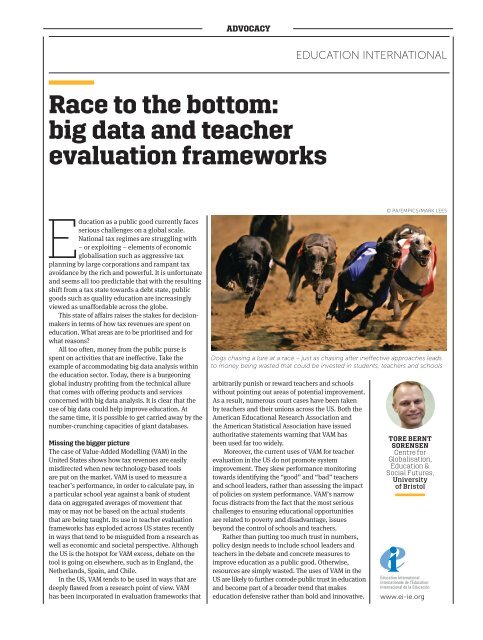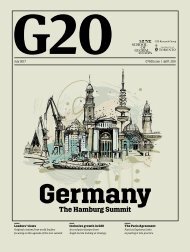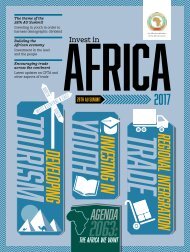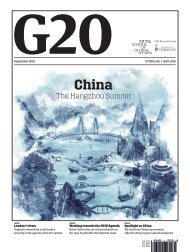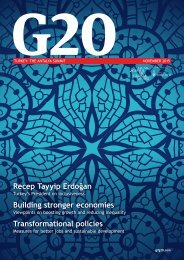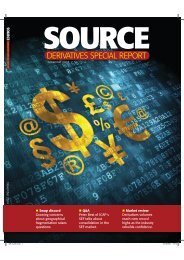G7_JAPAN
Create successful ePaper yourself
Turn your PDF publications into a flip-book with our unique Google optimized e-Paper software.
ADVOCACY<br />
EDUCATION INTERNATIONAL<br />
Race to the bottom:<br />
big data and teacher<br />
evaluation frameworks<br />
Education as a public good currently faces<br />
serious challenges on a global scale.<br />
National tax regimes are struggling with<br />
– or exploiting – elements of economic<br />
globalisation such as aggressive tax<br />
planning by large corporations and rampant tax<br />
avoidance by the rich and powerful. It is unfortunate<br />
and seems all too predictable that with the resulting<br />
shift from a tax state towards a debt state, public<br />
goods such as quality education are increasingly<br />
viewed as unaffordable across the globe.<br />
This state of affairs raises the stakes for decisionmakers<br />
in terms of how tax revenues are spent on<br />
education. What areas are to be prioritised and for<br />
what reasons?<br />
All too often, money from the public purse is<br />
spent on activities that are ineffective. Take the<br />
example of accommodating big data analysis within<br />
the education sector. Today, there is a burgeoning<br />
global industry profiting from the technical allure<br />
that comes with offering products and services<br />
concerned with big data analysis. It is clear that the<br />
use of big data could help improve education. At<br />
the same time, it is possible to get carried away by the<br />
number-crunching capacities of giant databases.<br />
Missing the bigger picture<br />
The case of Value-Added Modelling (VAM) in the<br />
United States shows how tax revenues are easily<br />
misdirected when new technology-based tools<br />
are put on the market. VAM is used to measure a<br />
teacher’s performance, in order to calculate pay, in<br />
a particular school year against a bank of student<br />
data on aggregated averages of movement that<br />
may or may not be based on the actual students<br />
that are being taught. Its use in teacher evaluation<br />
frameworks has exploded across US states recently<br />
in ways that tend to be misguided from a research as<br />
well as economic and societal perspective. Although<br />
the US is the hotspot for VAM excess, debate on the<br />
tool is going on elsewhere, such as in England, the<br />
Netherlands, Spain, and Chile.<br />
In the US, VAM tends to be used in ways that are<br />
deeply flawed from a research point of view. VAM<br />
has been incorporated in evaluation frameworks that<br />
Dogs chasing a lure at a race – just as chasing after ineffective approaches leads<br />
to money being wasted that could be invested in students, teachers and schools<br />
arbitrarily punish or reward teachers and schools<br />
without pointing out areas of potential improvement.<br />
As a result, numerous court cases have been taken<br />
by teachers and their unions across the US. Both the<br />
American Educational Research Association and<br />
the American Statistical Association have issued<br />
authoritative statements warning that VAM has<br />
been used far too widely.<br />
Moreover, the current uses of VAM for teacher<br />
evaluation in the US do not promote system<br />
improvement. They skew performance monitoring<br />
towards identifying the “good” and “bad” teachers<br />
and school leaders, rather than assessing the impact<br />
of policies on system performance. VAM’s narrow<br />
focus distracts from the fact that the most serious<br />
challenges to ensuring educational opportunities<br />
are related to poverty and disadvantage, issues<br />
beyond the control of schools and teachers.<br />
Rather than putting too much trust in numbers,<br />
policy design needs to include school leaders and<br />
teachers in the debate and concrete measures to<br />
improve education as a public good. Otherwise,<br />
resources are simply wasted. The uses of VAM in the<br />
US are likely to further corrode public trust in education<br />
and become part of a broader trend that makes<br />
education defensive rather than bold and innovative.<br />
© PA/EMPICS/MARK LEES<br />
TORE BERNT<br />
SORENSEN<br />
Centre for<br />
Globalisation,<br />
Education &<br />
Social Futures,<br />
University<br />
of Bristol<br />
www.ei-ie.org


